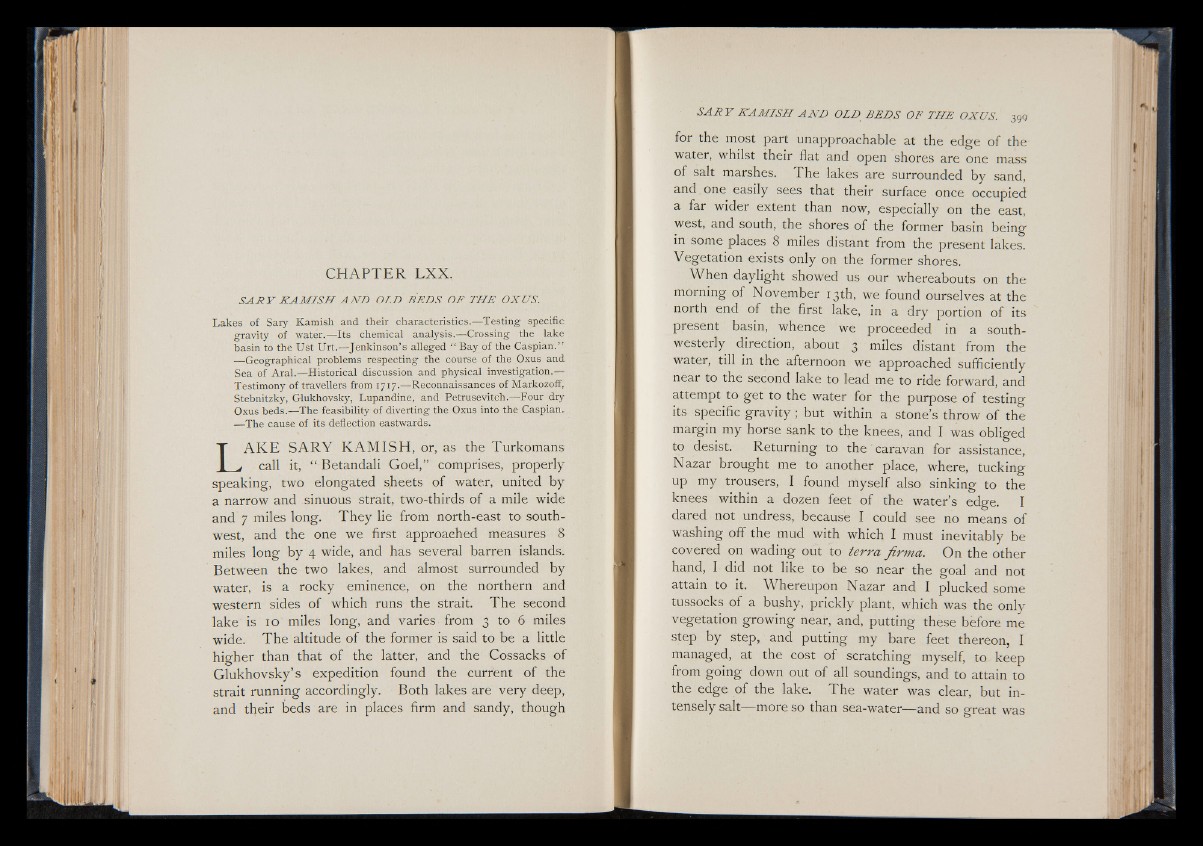
C H A P T E R LX X .
S A R Y K A M ISH A N D OLD B ED S OF THE OXUS.
Lakes of Sary Kamish and their characteristics.—Testing specific
gravity of water.—Its chemical analysis.—Crossing the lake
basin to the Ust Urt.—Jenkinson’s alleged “ Bay of the Caspian.”
— Geographical problems respecting the course of the Oxus and
Sea of Aral.—Historical discussion and physical investigation.—
Testimony of travellers from 1717.—Reconnaissances of Markozoff,
Stebnitzky, Glukhovsky, Lupandine, and Petrusevitch.— Four dry
Oxus beds.—The feasibility of diverting the Oxus into the Caspian.
— The cause of its deflection eastwards.
LA K E S A R Y K AM ISH , or, as the Turkomans
call it, “ Betandali Goel,” comprises, properly
speaking, two elongated sheets of water, united by
a narrow and sinuous strait, two-thirds of a mile wide
and 7 miles long. They lie from north-east to southwest,
and the one we first approached measures 8
miles long by 4 wide, and has several barren islands.
Between the two lakes, and almost surrounded by
water, is a rocky eminence, on the northern and
western sides of which runs the strait. The second
lake is 10 miles long, and varies from 3 to 6 miles
wide. The altitude of the former is said to be a little
higher than that of the latter, and the Cossacks o f
Glukhovsky’ s expedition found the current of the
strait running accordingly. Both lakes are very deep,
and their beds are in places firm and sandy, though
for the most part unapproachable at the edge of the
water, whilst their flat and open shores are one mass
of salt marshes. The lakes are surrounded by sand,
and . one easily sees that their surface once occupied
a far wider extent than now, especially on the east,
west, and south, the shores of the former basin being
in some places 8 miles distant from the present lakes.
Vegetation exists only on the former shores.
When daylight showed us our whereabouts on the
morning of November 13th, we found ourselves at the
north end of the first lake, in a dry portion of its
present basin, whence we proceeded in a southwesterly
direction, about 3 miles distant from the
water, till in the afternoon we approached sufficiently
near to the second lake to lead me to ride forward, and
attempt to get to the water for the purpose of testing
its specific g ra v ity ; but within a stone’s throw of the
margin my horse sank to the knees, and I was obliged
to desist. Returning to th e ' caravan for assistance,
Nazar brought me to another place, where, tucking
up my trousers, I found myself also sinking to the
knees within a dozen feet o f the water’s edge. I
dared not undress, because I could see no means o f
washing off the mud with which I must inevitably be
covered on wading out to terra firma. On the other
hand, I did not like to be so near the goal and not
attain to it. Whereupon Nazar and I plucked some
tussocks of a bushy, prickly plant, which was the only
vegetation growing near, and, putting these before me
step by step, and putting my bare feet thereon, I
managed, at the cost o f scratching myself, to keep
from going down out of all soundings, and to attain to
the edge of the lake. The water was clear, but intensely
salt— more so than sea-water— and so great was